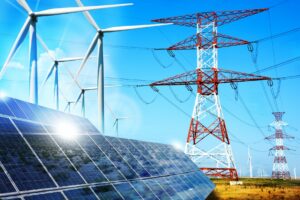 On September 8, 2021, the Department of Energy (DOE) released its Solar Futures Study providing a blueprint for the role of solar energy in decarbonizing the nation’s power sector. The 310-page Study outlines a future in which solar provides 40% of the nation’s electricity supply by 2035 through cost reductions, technological improvement, rapid deployment, and supportive policies. And, with the electrification of buildings and the transportation sector, solar could also power 30% of all building end uses and 14% of transportation end uses by 2050.
On September 8, 2021, the Department of Energy (DOE) released its Solar Futures Study providing a blueprint for the role of solar energy in decarbonizing the nation’s power sector. The 310-page Study outlines a future in which solar provides 40% of the nation’s electricity supply by 2035 through cost reductions, technological improvement, rapid deployment, and supportive policies. And, with the electrification of buildings and the transportation sector, solar could also power 30% of all building end uses and 14% of transportation end uses by 2050.
The Study identifies several policy initiatives needed to support the deployment of solar at this scale, including decarbonization targets, R&D investments and cost reductions, changes to wholesale electricity market regulation, and transmission development, to name a few. In order to meet the 40% by 2035 goal, the Study estimates that the U.S. must install an average of 30 GW of solar capacity per year between now and 2025 and 60 GW per year from 2025-2030, with a total of 1,000 GW of solar deployed by 2035. If the solar industry sees this level of growth, the Study estimates that the industry could employ up to 1.5 million people by 2035. The Study also highlights the important role that battery storage and demand-side management will play given that solar power varies based on daily and seasonal patterns.
With solar power currently providing approximately 3% of the nation’s electricity supply, the DOE’s 40% goal will be contingent on many factors supporting the industry in the coming years, including cost reductions, supportive policies, and widespread deployment.
 On July 12, 2021, Ohio Governor Mike DeWine signed into law Senate Bill 52 providing counties with the authority to block the construction of certain large solar and wind facilities in unincorporated townships. The law goes into effect on October 11, 2021. In short, Senate Bill 52 allows county commissioners to establish restricted areas in unincorporated townships prohibiting the construction of solar developments with generating capacity over 50 MWs and wind farms with over 5 MWs of generating capacity. If a township is incorporated, it retains jurisdiction to regulate whether the development occurs rather than defer to the county commissioners. Senate Bill 52 also contains requirements pertaining to public meetings in the counties that the facility will be located and decommissioning requirements. Practically speaking, Senate Bill 52 means that even if a solar or wind company obtains the necessary land rights to construct a solar or wind facility, counties can block its construction.
On July 12, 2021, Ohio Governor Mike DeWine signed into law Senate Bill 52 providing counties with the authority to block the construction of certain large solar and wind facilities in unincorporated townships. The law goes into effect on October 11, 2021. In short, Senate Bill 52 allows county commissioners to establish restricted areas in unincorporated townships prohibiting the construction of solar developments with generating capacity over 50 MWs and wind farms with over 5 MWs of generating capacity. If a township is incorporated, it retains jurisdiction to regulate whether the development occurs rather than defer to the county commissioners. Senate Bill 52 also contains requirements pertaining to public meetings in the counties that the facility will be located and decommissioning requirements. Practically speaking, Senate Bill 52 means that even if a solar or wind company obtains the necessary land rights to construct a solar or wind facility, counties can block its construction.
Senate Bill 52 follows a string of legislative actions in Ohio that appear to have stifled development and investment in solar and wind in the state. For example, in 2014, Ohio passed legislation requiring wind farms to be setback a minimum of 1,125 feet from the nearest adjacent property line. In contrast, oil and gas production wells are only required to be located at least 100 feet from the nearest homes. Since Ohio enacted the wind farm setback requirement, only one wind farm has been approved in the state.
While the full impact of Senate Bill 52 is unknown at this time, solar and wind developers can expect some counties to begin using their authority to restrict the location of solar and wind developments after the law goes into effect in October.
 A financial rebound is in progress as COVID-19 becomes less of a driver to business and our general livelihood, and it is one that is apparent in the renewables sector. Experts see growth fueled not just by pent-up demand, but also growing attention to ESG considerations and renewables’ financial advantages.
A financial rebound is in progress as COVID-19 becomes less of a driver to business and our general livelihood, and it is one that is apparent in the renewables sector. Experts see growth fueled not just by pent-up demand, but also growing attention to ESG considerations and renewables’ financial advantages.
Corporate merger and acquisition activity was up significantly with solar developers expanding their pipelines, oil and gas companies diversifying into renewables, and funds buying up renewable assets.
According to Mercom CEO Raj Prabhu, Solar project acquisitions reached a record high in the second quarter, he said, with more than 24.7 GW of capacity acquired. That total came from 34 corporate M&A deals, compared to 20 in the first quarter of this year and 13 in the second quarter of 2020.
In the first half of 2021, solar project acquisitions reached 39.3 GW, more than doubling the 14.7 GW acquired in the first half of 2020.
Venture capital funding in particular has experienced a strong recovery. Funding for VC was 680% higher in the first half of the year, compared with last year, with $1.6 billion raised in 26 deals, according to Mercom.
Renewables have been rapidly gaining market share for years. In 2020, the United States saw its fifth consecutive year of renewables consumption growth, reaching a record high of 12% of the country’s total consumption, according to the U.S. Energy Information Administration (EIA).
EIA estimates solar energy accounted for about 11% of last year’s renewable energy consumption, and “overall, 2020 U.S. solar consumption increased 22% from 2019.”
By comparison, the agency said fossil fuel consumption fell last year by 9% to “the lowest level in nearly 30 years.”
The trend is represented globally as well. The International Energy Agency’s (IEA) most recent market update, released in May, found renewable electricity capacity added in 2020 rose by 45% to 280 GW.
“Solar PV installations will continue to break new records, with annual additions forecast to reach over 160 GW by 2022,” IEA said in its analysis. “That would be almost 50% higher than the level achieved in 2019 prior to the pandemic, affirming solar’s position as the ‘new king’ of global electricity markets.”
Corporate solar interest surges as companies exit pandemic and turn focus to ESG issues | Utility Dive
Developers of renewables projects are once again facing regulatory uncertainty regarding the scope of the Migratory Bird Treaty Act (“MBTA”) as a result of a proposed rule issued on May 7 by the U.S. Fish and Wildlife Service (“USFWS”). The proposed rule, if finalized as issued, would revoke a rule issued in the last days of the Trump administration stipulating that deaths of migratory birds occurring incidental to lawful activities (i.e., incidental take) are not prohibited under the MBTA.
The proposed rule represents the latest development in a long-running debate. At issue is whether the MBTA, a law passed in 1918 that was originally intended to prevent the extinction of migratory bird species due to commercial trade and hunting practices, prohibits the incidental taking of protected birds as a result of activities that are otherwise lawful, such as the operation of wind turbines or the clearing of land for a solar project, or whether the law prohibits only the intentional take (i.e., purposeful killing) of protected species. The issue has resulted in a split among U.S. Circuit Courts of Appeals, as well as completely opposite legal interpretations issued by two Solicitors of the Department of Interior within the span of one year in 2017.
By revoking the prior rule, the USFWS would revert to interpreting the MBTA to prohibit incidental take of birds protected under the act, and to employing agency discretion in determining whether an incidental take of such birds warrants an enforcement action. The proposed rule highlights the need for renewable project developers to implement best practices for avoiding the unintended take of protected migratory birds as a means of qualifying for agency enforcement discretion and thus avoiding fines for noncompliance. For wind energy projects, this can largely be accomplished through complying with the USFWS’s Land-Based Wind Energy Guidelines, although there is no guarantee that such compliance will preclude an enforcement action. There are no solar-specific guidelines currently in place. While the risk posed to migratory birds from solar projects is less than that for wind projects, solar developers should nonetheless implement best practices for reducing impacts to birds, including the general Nationwide Standard Conservation Measures for project development.
 On March 25, 2021, the Department of Energy (DOE) announced plans to reduce the cost of solar energy technologies by 60% over the next 10 years by setting new cost targets and establishing funding opportunities. The DOE accelerated its cost target for utility-scale solar by establishing a new goal of driving down the current cost of 4.6 cents per kilowatt-hour (kWh) to 3 cents/kWh by 2025 and 2 cents/kWh by 2030. The DOE also announced $128 million in funding and initiatives aimed at lowering costs, improving performance, and speeding up the deployment of solar energy. Specifically, the DOE announced funding for advancing solar photovoltaic (PV) materials and a prize competition for perovskite technologies, increasing the lifetime of silicon-based PV systems, and supporting several concentrating solar-thermal power projects. The DOE stated that in order to meet the Biden Administration’s goal of 100% clean electricity by 2035, lowering the cost of solar energy technologies is needed to accelerate investment and deployment. More information about DOE’s funding opportunities can be found here: https://www.energy.gov/eere/solar/funding-opportunities
On March 25, 2021, the Department of Energy (DOE) announced plans to reduce the cost of solar energy technologies by 60% over the next 10 years by setting new cost targets and establishing funding opportunities. The DOE accelerated its cost target for utility-scale solar by establishing a new goal of driving down the current cost of 4.6 cents per kilowatt-hour (kWh) to 3 cents/kWh by 2025 and 2 cents/kWh by 2030. The DOE also announced $128 million in funding and initiatives aimed at lowering costs, improving performance, and speeding up the deployment of solar energy. Specifically, the DOE announced funding for advancing solar photovoltaic (PV) materials and a prize competition for perovskite technologies, increasing the lifetime of silicon-based PV systems, and supporting several concentrating solar-thermal power projects. The DOE stated that in order to meet the Biden Administration’s goal of 100% clean electricity by 2035, lowering the cost of solar energy technologies is needed to accelerate investment and deployment. More information about DOE’s funding opportunities can be found here: https://www.energy.gov/eere/solar/funding-opportunities
In another sign of various sectors of the energy industry coming together to advance decarbonization, Enterprise Products Partners LP, a company focused on pipeline, storage and natural gas processing, among other services and products to the energy industry, signed a virtual power purchase agreement for solar energy from the Space City Solar project located in Wharton County, Texas. “We are committed to being a responsible steward of the environment, including using energy sustainably across our footprint,” A.J. “Jim” Teague, co-CEO of the Houston-based midstream company’s general partner, said in a statement on March 1. The PPA made with EDF Renewables North America is the result, Teague said, of an initiative launched by Enterprise Products in 2020 to expand solar power purchasing and/or installations across its system. “We estimate that by 2025, approximately 25% of our power will be from renewable resources.” The Space City Solar project is expected to commence construction in Summer 2021 and begin delivery of clean electricity in Summer 2022. The power purchase agreement between EDF Renewables and an affiliate of Enterprise Products was for a second tranche of the project for 100 MWac/132 MWdc. The project’s total capacity is up to 345 MWac/455 MWdc. Approximately 300 jobs are expected to be created during the construction phase with more than $30 million generated in new tax revenue over the operating life for Wharton County taxing entities, according to a joint release from Enterprise and EDF.
EDF Renewables North America Signs Virtual Power Purchase Agreement with Enterprise Products for Solar Energy | Business Wire
 A recently settled enforcement action against a solar project developer in Massachusetts underscores the importance of adhering to appropriate stormwater pollution prevention protocols when siting, designing and constructing a project. The Commonwealth of Massachusetts sued the project developer under state and federal environmental laws, alleging that they had constructed a solar array on a hillside parcel without designing or implementing the required stormwater controls. Specifically, the Commonwealth alleged that the developer never properly analyzed the potential for harm from stormwater discharges resulting from construction of the solar array, failed to install necessary stormwater controls prior to conducting site clearing and grading activities, applied for a General Stormwater Permit for construction activities (Permit) without having first prepared a Stormwater Pollution Prevention Plan (SWPPP), and ultimately failed to comply with requirements of the Permit and SWPPP that are designed to prevent stormwater pollution. As a result, the Commonwealth claimed, there was an extensive discharge of sediment-laden stormwater over several months into a downgradient river that adversely affected the river’s water quality, and also eroded the hillside, scoured out perennial and intermittent streams, uprooted trees, destroyed streambeds, and filled in wetlands with sediment. The developer has agreed to pay more than $1 million to settle the claim, which includes the cost of restoring impacted natural resources, compensatory mitigation costs, the Commonwealth’s legal fees, and a $100,000 civil penalty.
A recently settled enforcement action against a solar project developer in Massachusetts underscores the importance of adhering to appropriate stormwater pollution prevention protocols when siting, designing and constructing a project. The Commonwealth of Massachusetts sued the project developer under state and federal environmental laws, alleging that they had constructed a solar array on a hillside parcel without designing or implementing the required stormwater controls. Specifically, the Commonwealth alleged that the developer never properly analyzed the potential for harm from stormwater discharges resulting from construction of the solar array, failed to install necessary stormwater controls prior to conducting site clearing and grading activities, applied for a General Stormwater Permit for construction activities (Permit) without having first prepared a Stormwater Pollution Prevention Plan (SWPPP), and ultimately failed to comply with requirements of the Permit and SWPPP that are designed to prevent stormwater pollution. As a result, the Commonwealth claimed, there was an extensive discharge of sediment-laden stormwater over several months into a downgradient river that adversely affected the river’s water quality, and also eroded the hillside, scoured out perennial and intermittent streams, uprooted trees, destroyed streambeds, and filled in wetlands with sediment. The developer has agreed to pay more than $1 million to settle the claim, which includes the cost of restoring impacted natural resources, compensatory mitigation costs, the Commonwealth’s legal fees, and a $100,000 civil penalty.
The case is an important reminder that renewables projects face the same environmental compliance obligations as any other large-scale infrastructure project, and that such projects, while considered “green,” are not immune from environmental enforcement actions. While renewables projects are often scrutinized for potential impacts to protected species, a greater risk of liability may lie in a project’s failure to comply with more “run of the mill” permitting and compliance requirements. For more information on this case, please click here.
 Following the passage of West Virginia Senate Bill 583 in early 2020, West Virginia has seen an uptick in the number of new proposed renewable energy projects. SB 583 established a new incentive program supporting the development of renewable energy facilities on former industrial sites. Berkeley County, in the eastern panhandle, recently announced a proposed 100 MW solar facility to be built on a 750 acre brownfield site previously used as a manufacturing facility. Read more.
Following the passage of West Virginia Senate Bill 583 in early 2020, West Virginia has seen an uptick in the number of new proposed renewable energy projects. SB 583 established a new incentive program supporting the development of renewable energy facilities on former industrial sites. Berkeley County, in the eastern panhandle, recently announced a proposed 100 MW solar facility to be built on a 750 acre brownfield site previously used as a manufacturing facility. Read more.
 The recently approved federal spending bill for 2021 appropriations (December 27, 2020) included extensions to the federal solar investment tax credit (ITC) and wind production tax credit (PTC). The ITC and PTC provide significant financial incentives to the growing renewable energy industry. The ITC is a tax credit that can be claimed on federal corporate income taxes for a percent of the cost of a solar photovoltaic (PV) system that is placed in service. The ITC, which was scheduled to step down from 26% to 22% in 2021, has been extended at its current 26% rate for an additional two years through 2023. The PTC is a per-kilowatt-hour (kWh) tax credit for electricity generated using qualified energy resources including wind, and was scheduled to phase down from 60% of the original credit to 40% in 2021. The new spending bill included an extension of the 60% rate for an additional year through 2021. Projects must be commenced prior to the expiration of the new extension deadlines in order to qualify for the current tax credit rate. Please click here for more information.
The recently approved federal spending bill for 2021 appropriations (December 27, 2020) included extensions to the federal solar investment tax credit (ITC) and wind production tax credit (PTC). The ITC and PTC provide significant financial incentives to the growing renewable energy industry. The ITC is a tax credit that can be claimed on federal corporate income taxes for a percent of the cost of a solar photovoltaic (PV) system that is placed in service. The ITC, which was scheduled to step down from 26% to 22% in 2021, has been extended at its current 26% rate for an additional two years through 2023. The PTC is a per-kilowatt-hour (kWh) tax credit for electricity generated using qualified energy resources including wind, and was scheduled to phase down from 60% of the original credit to 40% in 2021. The new spending bill included an extension of the 60% rate for an additional year through 2021. Projects must be commenced prior to the expiration of the new extension deadlines in order to qualify for the current tax credit rate. Please click here for more information.
 On September 8, 2021, the Department of Energy (DOE) released its Solar Futures Study providing a blueprint for the role of solar energy in decarbonizing the nation’s power sector. The 310-page Study outlines a future in which solar provides 40% of the nation’s electricity supply by 2035 through cost reductions, technological improvement, rapid deployment, and supportive policies. And, with the electrification of buildings and the transportation sector, solar could also power 30% of all building end uses and 14% of transportation end uses by 2050.
On September 8, 2021, the Department of Energy (DOE) released its Solar Futures Study providing a blueprint for the role of solar energy in decarbonizing the nation’s power sector. The 310-page Study outlines a future in which solar provides 40% of the nation’s electricity supply by 2035 through cost reductions, technological improvement, rapid deployment, and supportive policies. And, with the electrification of buildings and the transportation sector, solar could also power 30% of all building end uses and 14% of transportation end uses by 2050. On July 12, 2021, Ohio Governor Mike DeWine signed into law
On July 12, 2021, Ohio Governor Mike DeWine signed into law  A financial rebound is in progress as COVID-19 becomes less of a driver to business and our general livelihood, and it is one that is apparent in the renewables sector. Experts see growth fueled not just by pent-up demand, but also growing attention to ESG considerations and renewables’ financial advantages.
A financial rebound is in progress as COVID-19 becomes less of a driver to business and our general livelihood, and it is one that is apparent in the renewables sector. Experts see growth fueled not just by pent-up demand, but also growing attention to ESG considerations and renewables’ financial advantages. On March 25, 2021, the Department of Energy (DOE)
On March 25, 2021, the Department of Energy (DOE)  A recently settled enforcement action against a solar project developer in Massachusetts underscores the importance of adhering to appropriate stormwater pollution prevention protocols when siting, designing and constructing a project. The Commonwealth of Massachusetts sued the project developer under state and federal environmental laws, alleging that they had constructed a solar array on a hillside parcel without designing or implementing the required stormwater controls. Specifically, the Commonwealth alleged that the developer never properly analyzed the potential for harm from stormwater discharges resulting from construction of the solar array, failed to install necessary stormwater controls prior to conducting site clearing and grading activities, applied for a General Stormwater Permit for construction activities (Permit) without having first prepared a Stormwater Pollution Prevention Plan (SWPPP), and ultimately failed to comply with requirements of the Permit and SWPPP that are designed to prevent stormwater pollution. As a result, the Commonwealth claimed, there was an extensive discharge of sediment-laden stormwater over several months into a downgradient river that adversely affected the river’s water quality, and also eroded the hillside, scoured out perennial and intermittent streams, uprooted trees, destroyed streambeds, and filled in wetlands with sediment. The developer has agreed to pay more than $1 million to settle the claim, which includes the cost of restoring impacted natural resources, compensatory mitigation costs, the Commonwealth’s legal fees, and a $100,000 civil penalty.
A recently settled enforcement action against a solar project developer in Massachusetts underscores the importance of adhering to appropriate stormwater pollution prevention protocols when siting, designing and constructing a project. The Commonwealth of Massachusetts sued the project developer under state and federal environmental laws, alleging that they had constructed a solar array on a hillside parcel without designing or implementing the required stormwater controls. Specifically, the Commonwealth alleged that the developer never properly analyzed the potential for harm from stormwater discharges resulting from construction of the solar array, failed to install necessary stormwater controls prior to conducting site clearing and grading activities, applied for a General Stormwater Permit for construction activities (Permit) without having first prepared a Stormwater Pollution Prevention Plan (SWPPP), and ultimately failed to comply with requirements of the Permit and SWPPP that are designed to prevent stormwater pollution. As a result, the Commonwealth claimed, there was an extensive discharge of sediment-laden stormwater over several months into a downgradient river that adversely affected the river’s water quality, and also eroded the hillside, scoured out perennial and intermittent streams, uprooted trees, destroyed streambeds, and filled in wetlands with sediment. The developer has agreed to pay more than $1 million to settle the claim, which includes the cost of restoring impacted natural resources, compensatory mitigation costs, the Commonwealth’s legal fees, and a $100,000 civil penalty. Following the passage of West Virginia Senate Bill 583 in early 2020, West Virginia has seen an uptick in the number of new proposed renewable energy projects. SB 583 established a new incentive program supporting the development of renewable energy facilities on former industrial sites. Berkeley County, in the eastern panhandle, recently announced a proposed 100 MW solar facility to be built on a 750 acre brownfield site previously used as a manufacturing facility.
Following the passage of West Virginia Senate Bill 583 in early 2020, West Virginia has seen an uptick in the number of new proposed renewable energy projects. SB 583 established a new incentive program supporting the development of renewable energy facilities on former industrial sites. Berkeley County, in the eastern panhandle, recently announced a proposed 100 MW solar facility to be built on a 750 acre brownfield site previously used as a manufacturing facility.  The recently approved federal spending bill for 2021 appropriations (December 27, 2020) included extensions to the federal solar investment tax credit (ITC) and wind production tax credit (PTC). The ITC and PTC provide significant financial incentives to the growing renewable energy industry. The ITC is a tax credit that can be claimed on federal corporate income taxes for a percent of the cost of a solar photovoltaic (PV) system that is placed in service. The ITC, which was scheduled to step down from 26% to 22% in 2021, has been extended at its current 26% rate for an additional two years through 2023. The PTC is a per-kilowatt-hour (kWh) tax credit for electricity generated using qualified energy resources including wind, and was scheduled to phase down from 60% of the original credit to 40% in 2021. The new spending bill included an extension of the 60% rate for an additional year through 2021. Projects must be commenced prior to the expiration of the new extension deadlines in order to qualify for the current tax credit rate.
The recently approved federal spending bill for 2021 appropriations (December 27, 2020) included extensions to the federal solar investment tax credit (ITC) and wind production tax credit (PTC). The ITC and PTC provide significant financial incentives to the growing renewable energy industry. The ITC is a tax credit that can be claimed on federal corporate income taxes for a percent of the cost of a solar photovoltaic (PV) system that is placed in service. The ITC, which was scheduled to step down from 26% to 22% in 2021, has been extended at its current 26% rate for an additional two years through 2023. The PTC is a per-kilowatt-hour (kWh) tax credit for electricity generated using qualified energy resources including wind, and was scheduled to phase down from 60% of the original credit to 40% in 2021. The new spending bill included an extension of the 60% rate for an additional year through 2021. Projects must be commenced prior to the expiration of the new extension deadlines in order to qualify for the current tax credit rate.